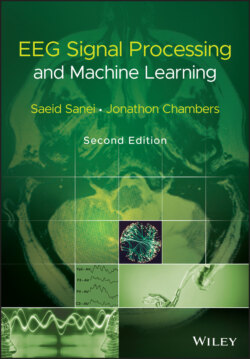Читать книгу EEG Signal Processing and Machine Learning - Saeid Sanei - Страница 43
3.2.3 Hodgkin–Huxley Model
ОглавлениеMost probably the earliest physical model is based on the Hodgkin and Huxley's Nobel Prize winning mathematical model for a squid axon published in 1952 [8–10]. The Hodgkin and Huxley equations are important not only because they represent the most successful mathematical model in quantitatively describing the related biological phenomena but also due to the fact that deriving the model of a squid is directly applicable to many kinds of neurons and other excitable cells. According to this model, a nerve axon may be stimulated and the activated sodium (Na+) and potassium (K+) channels produced in the vicinity of the cell membrane can lead to the electrical excitation of the nerve axon. The excitation arises from the effect of the membrane potential on the movement of ions, and from interactions of the membrane potential with the opening and closing of voltage activated membrane channels. The membrane potential increases when the membrane is polarized with a net negative charge lining the inner surface and an equal but opposite net positive charge on the outer surface. This potential may be simply related to the amount of electrical charge Q, using:
(3.13)
where Q is in terms of Coulombs cm−2, Cm is the measure of the capacity of the membrane and has units farads cm−2 and E has units of volts. In practise, in order to model the APs the amount of charge Q+ on the inner surface (and Q− on the outer surface) of the cell membrane has to be mathematically related to the stimulating current I stim flowing into the cell through the stimulating electrodes. Figure 3.1b illustrates how the neuron excitation results in generation of APs by acting as a signal converter [11].
The electrical potential (often called electrical force) E is then calculated using Eq. (3.13). The Hodgkin and Huxley's model is illustrated in Figure 3.3. In this figure Imemb is the result of positive charges flowing out of the cell. This current consists of mainly three currents namely, Na, K, and leak currents. The leak current is due to the fact that the inner and outer Na and K ions are not exactly equal.
Hodgkin and Huxley estimated the activation and inactivation functions for the Na and K currents and derived a mathematical model to describe an AP similar to that of a giant squid. The model is a neuron model that uses voltage‐gated channels. The space‐clamped version of the Hodgkin–Huxley model may be well described using four ordinary differential equations [12]. This model describes the change in the membrane potential (E) with respect to time and is described in [13]. The overall membrane current is the sum of capacity current and ionic current as:
(3.14)
Figure 3.3 The Hodgkin–Huxley excitation model.
where Ii is the ionic current and as indicated in Figure 3.1 which can be considered as the sum of three individual components: Na, K, and leak currents:
(3.15)
INa can be related to the maximal conductance , activation variable aNa , inactivation variable hNa , and a driving force (E – ENa ) through:
(3.16)
Similarly Ik can be related to the maximal conductance , activation variable aK , and a driving force (E – EK ) as:
(3.17)
and Ileak is related to the maximal conductance and a driving force (E – El ) as:
(3.18)
The changes in the variables aNa , ak , and hNa vary from 0 to 1 according to the following equations:
(3.19)
(3.20)
(3.21)
where α(E) and β(E) are respectively forward and backward rate functions and λt is a temperature‐dependent factor. The forward and backward parameters depend on voltage and were empirically estimated by Hodgkin and Huxley as:
(3.22)
(3.23)
(3.24)
(3.25)
(3.26)
(3.27)
As stated in the Simulator for Neural Networks and Action Potentials (SNNAP) literature [12], the α(E) and β(E) parameters have been converted from the original Hodgkin–Huxley version to agree with the present physiological practice where depolarization of the membrane is taken to be positive. In addition, the resting potential has been shifted to –60 mV (from the original 0 mV). These equations are used in the model described in the SNNAP. In Figure 3.4 an AP has been simulated. For this model the parameters are set to Cm = 1.1 μF cm−2, = 100 ms cm−2, = 35 mS cm−2, = 0.35 mS cm−2, and ENa = 60 mV.
The simulation can run to generate a series of APs as practically happens in the case of event‐related potential (ERP) signals. If the maximal ionic conductance of the potassium current , is reduced the model will show a higher resting potential. Also, for = 16 mS cm−2, the model will begin to exhibit oscillatory behaviour. Figure 3.5 shows the result of a Hodgkin–Huxley oscillatory model with reduced maximal potassium conductance.
The SNNAP can also model bursting neurons and central pattern generators. This stems from the fact that many neurons show cyclic spiky activities followed by a period of inactivity. Several invertebrate as well as mammalian neurons are bursting cells and exhibit alternating periods of high‐frequency spiking behaviour followed by a period of no spiking activity.
Figure 3.4 A single AP in response to a transient stimulation based on the Hodgkin–Huxley model. The initiated time is at t = 0.4 ms and the injected current is 80 μA cm−2 for a duration of 0.1 ms. The selected parameters are C m = 1.2 μF cm−2, = 100 mS cm−2, = 35 mS cm−2, = 0.35 mS cm−2, and ENa = 60 mV.
Figure 3.5 The AP from a Hodgkin–Huxley oscillatory model with reduced maximal potassium conductance.
